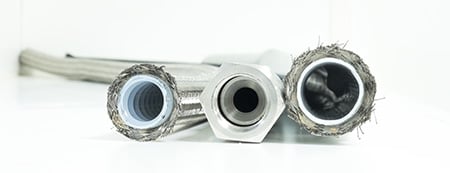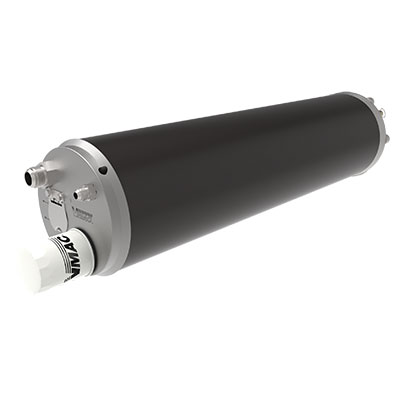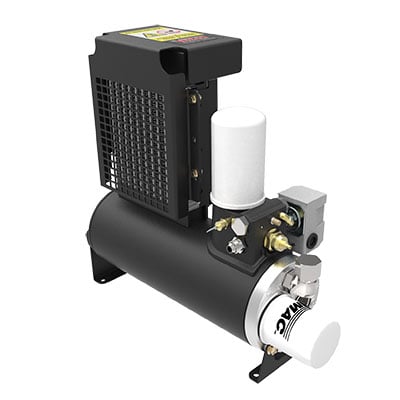Key Components of Your VMAC Rotary Screw Air Compressor System
VMAC vehicle-integrated air compressors, the UNDERHOOD and DTM, are expertly engineered for specific trucks and vans. Each installation kit comes with clear instructions on how the system should be installed. However, you may need to locate a few components and plumb hosing between them. In this article, we’ll briefly describe the primary components of a VMAC rotary screw compressor system and explain their functions.
While every VMAC air compressor system is slightly different, many share the same or similar components. Please keep in mind that the components may look different than the following images depending on your exact system.
The primary VMAC air compressor components are:
- Air Compressor
- Drive System
- Primary Separator Tank
- Secondary Separation Filter
- Oil Filter
- Oil Cooler
- Hoses
- Controls
- Air Filter
Air Compressor

The air compressor is the main component of your air system. The compressor is where atmospheric air is drawn in and compressed to a higher pressure. Compression (and cooling) is completed with the aid of rotary screw compressor oil that is injected into the compressor while the rotors spin.
Drive System

The compressor has moving parts and requires a power source to drive it. This power may be an engine driving a belt, hydraulic fluid, or a shaft. You can find more info on drive systems here.
Primary Separator Tank
When compressed air leaves the compressor it is mixed with compressor oil. The air-oil mixture enters a separator tank, which removes most of the oil from the air by directing the air in different directions to reduce velocity. This action allows the oil molecules to gather and form droplets that eventually fall to the bottom of the tank. A large amount of oil is removed from the air in this stage. Often, the primary separator tank also acts as an oil reservoir.
Secondary Separation Filter
 Once the compressed air leaves the primary separation tank it is nearly oil free. The remaining oil mist mixed with the air will enter the secondary separation filter, which is a coalescing filter. This filter comprises a membrane material that gathers the remaining oil particles and circulates the oil back into the oiling system. The air leaving the coalescing filter is considered oil-free. The secondary separation filter is attached to the primary separation tank or mounted remotely on its own filter manifold.
Once the compressed air leaves the primary separation tank it is nearly oil free. The remaining oil mist mixed with the air will enter the secondary separation filter, which is a coalescing filter. This filter comprises a membrane material that gathers the remaining oil particles and circulates the oil back into the oiling system. The air leaving the coalescing filter is considered oil-free. The secondary separation filter is attached to the primary separation tank or mounted remotely on its own filter manifold.
Oil Filter

As a rotary screw compressor has a closed loop oiling system, the installation must include an oil filter to remove contaminates before the oil is reused. The oil filter can be located on the compressor, the separator tank or mounted remotely on a filter manifold.
Oil Cooler

The process of compressing air generates heat, and lots of it! Compressor oil is used for sealing the rotors, lubrication, and cooling. The oil must pass through a cooler before it is circulated back to the compressor. A liquid-to-liquid cooler can be used in conjunction with an engine’s cooling system, or a stand-alone air-to-liquid cooler can be used; each has its benefits. The liquid-to-liquid version will need sufficient cooling capacity to cool the compressor oil. Meanwhile, the air-to-liquid cooler will need clean, cool air to keep the oil within an optimal temperature range.
Hoses

If your VMAC rotary screw air compressor system has components located in different places, which is the case for UNDERHOOD and Direct-Transmission Mounted systems, moving oil and air between them requires hoses. The hoses you choose must meet the heat, pressure, and chemical requirements of the compressor oil. Incorrect hose selection will result in premature failure of those hoses. Another consideration is hose routing, as you must ensure hoses are kept away from hot, moving, or sharp components to protect them from damage.
Controls

Whether the compressor system uses mechanical or electrical controls—in the form of buttons, a switch or level—they need to be easily accessible. Also consider the location of an auto-shutdown circuit for when the compressor gets too hot, and an hour meter to track compressor hours for servicing. The location and type of components used should also reflect the environment they will be used in.
Air Filter

The quality of air entering your compressor will affect the longevity of your system. Using an air filter suited for the environment and the air flow required is a necessity. That air filter can either be mounted directly to the compressor or remotely mounted and connected with an air intake hose. Cool, clean air should be considered when choosing the location of the filter.
All the components listed above are necessary, in some form, for your rotary screw air compressor system. There are many more options for filter manifolds, coolers, oil separators, and so forth, to help your system perform its best. Thoroughly understanding your requirements will guide your choice of components, while proper specifications, quality installation, and scheduled maintenance will help your system operate for years to come.
Learn more about rotary screw air compressors in our Easy Guide To Rotary Screw Air Compressors for Trucks & Vans.


